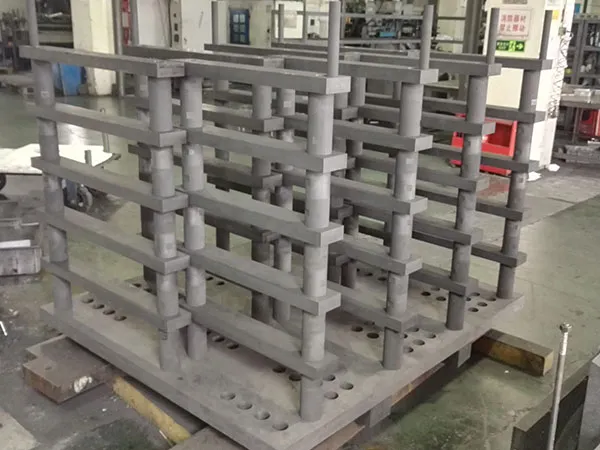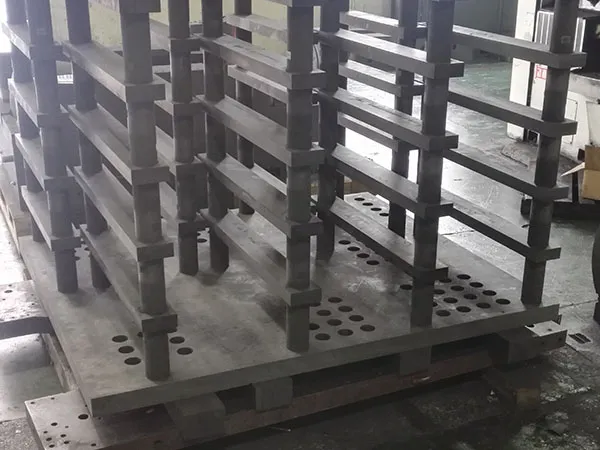Time: 2025-08-22 01:57:35 Source: Cangzhou Carbon Technology Co., Ltd.
Customizing a graphite rack for a vacuum furnace is a critical process for optimizing throughput, ensuring part quality, and maximizing the lifespan of your furnace components. A well-designed custom rack can make a significant difference in your operations.Customizing a vacuum furnace graphite rack involves a collaborative process with a manufacturer to design and fabricate a rack that meets your specific application needs.
Why Customize? The Benefits
Maximize Load Capacity: Fit more parts in each cycle, increasing throughput.
Improve Part Quality: Ensure uniform heating and gas flow around each part, reducing warpage and ensuring consistent metallurgical properties.
Prevent Contamination: Hold parts securely without direct contact where it's not desired, and use the right material grade to prevent reactions.
Enhance Ergonomics: Design for easy loading and unloading, reducing operator strain and cycle time.
Increase Rack Lifespan: Use the appropriate material and structural design to withstand thermal cycles and mechanical stress.

The process typically follows these steps:
Needs Assessment: You provide the manufacturer with the specifics of your application. This includes:
Part Geometry and Size: The dimensions and shape of the parts you will be placing in the rack.
Loading and Weight: The total weight of the parts the rack needs to support.
Operating Temperature: The maximum temperature the rack will be subjected to inside the furnace.
Required Durability: How long you expect the rack to last and how many thermal cycles it needs to endure.
Desired Throughput: The number of parts per batch you need to process.
|
Material Type |
Key Characteristics |
Best For... |
|
Isostatic Graphite |
Fine grain, high density, uniform strength in all directions. Excellent machinability. |
The most common choice for complex, high-strength racks and fixtures. Good all-around performance. |
|
Extruded Graphite |
Grain is aligned in one direction, making it stronger along that axis. More economical. |
Simple structural components like posts, beams, and large plates where stress is predictable. |
|
Molded Graphite |
Lower density and strength compared to isostatic. Most cost-effective. |
Less demanding applications, crucibles, or components not under significant mechanical load. |
|
Carbon Fiber Composite (CFC) |
Lightweight, extremely strong and rigid, highly resistant to thermal shock. More expensive. |
Large, self-supporting structures, applications where weight is a major concern, or for extremely rapid thermal cycles. |
Coatings:
Silicon Carbide (SiC) Coating: Creates a hard, non-porous surface. Prevents carbon dusting, increases wear resistance, and stops graphite from reacting with certain materials.
Pyrolytic Carbon (PyC) Coating: Seals the graphite surface, reducing porosity and outgassing. Ideal for high-purity semiconductor or electronics applications.
This is where your requirements are turned into a blueprint.
Initial Sketch: Create a simple sketch of your concept. How many levels? How will the parts be held?
CAD Modeling: Work with a manufacturer or designer to create a detailed 2D or 3D CAD model. A 3D model is highly recommended as it allows you to visualize the final product, check for clearances, and perform stress analysis.
Incorporate Key Design Principles:
Thermal Expansion: Graphite expands when heated. The design must include clearances and slip joints to prevent stress and warping. Posts should sit in holes with a small gap, not be press-fit.
Strength at Temperature: Graphite gets stronger with temperature (up to ~2500°C), but it's still brittle. Ensure beams and shelves are thick enough to support the full load without sagging over time.
Minimize Mass: Use the least amount of material necessary. A lighter rack heats and cools faster, saving energy and cycle time. Use cutouts and a skeletal design where possible.
Modularity: Design the rack with replaceable components. If a single shelf or post breaks, you can replace just that part instead of the entire rack.
Search for companies specializing in "graphite machining," "carbon composites," or "vacuum furnace fixtures."
What to look for:
Experience: Have they built fixtures for your industry or application before? Ask for case studies or examples.
Capabilities: Do they have modern CNC machines and the expertise to handle complex designs and brittle materials?
Engineering Support: A good supplier will act as a partner. They should review your design, point out potential flaws, and suggest improvements.
Quality Control: What are their inspection processes? Do they have a CMM (Coordinate Measuring Machine) to verify critical dimensions?

The manufacturer will provide you with a final set of drawings for approval.
Double-check every dimension, especially the overall external dimensions to ensure it fits in your furnace.
Confirm the material grade and any specified coatings.
Verify tolerances.
This is your last chance to make changes before machining begins. Measure twice, cut once.
The manufacturer will now machine the components from large blocks of graphite. This is typically done on 3-axis or 5-axis CNC mills. After machining, they will perform a quality inspection to ensure all parts meet the drawing specifications.
Once you receive your new custom rack, do not put it directly into a production run.
Clean: Wipe down all components with isopropyl alcohol and clean, lint-free cloths to remove any machining oils or dust.
Perform a Bake-Out Cycle: Run an empty, high-temperature cycle in the vacuum furnace. This drives off any volatile compounds and moisture absorbed by the graphite (outgassing). This "purifies" the rack and prevents contamination of your first product load.
Part-Specific Fixturing: To prevent parts from shifting or deforming during heat treatment, the rack can be designed with custom slots, grooves, or pockets that cradle each part securely. This improves the uniformity of heating and prevents damage.
Modular Design: For versatility and easy replacement, racks can be designed in a modular fashion. This allows you to replace individual shelves or components rather than the entire rack, reducing costs over time.
Weight Reduction: By strategically removing material from non-load-bearing areas, the rack's overall mass can be reduced. This decreases the thermal mass, leading to faster heat-up times, lower energy consumption, and more efficient processing.
Load Distribution: A well-designed custom rack ensures that the weight of the parts is evenly distributed across the rack's structure, preventing localized stress and potential failure.
By following this structured approach, you can successfully commission a custom graphite rack that will be a valuable and long-lasting asset for your vacuum furnace operations.